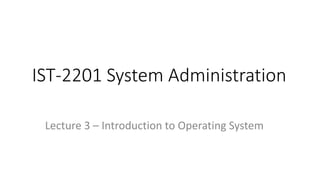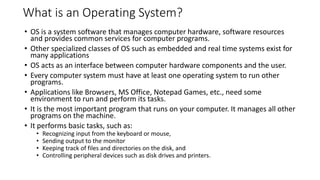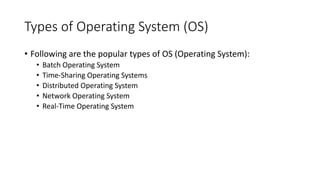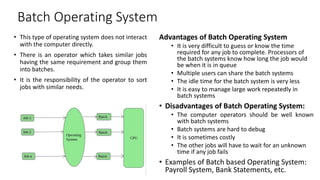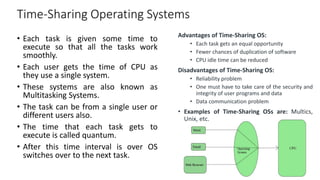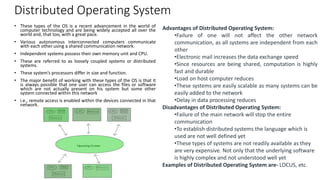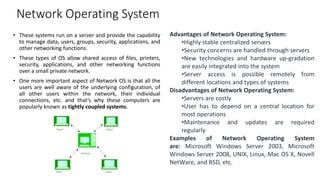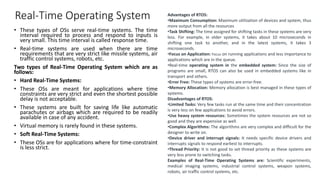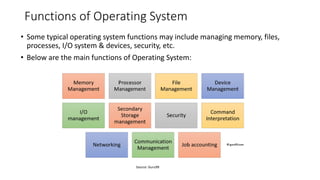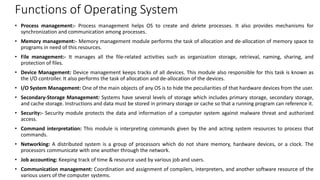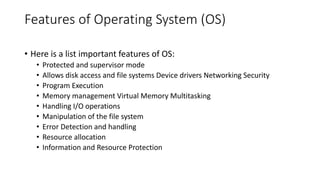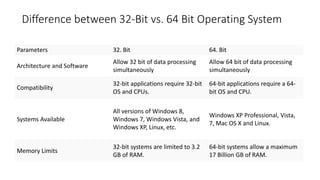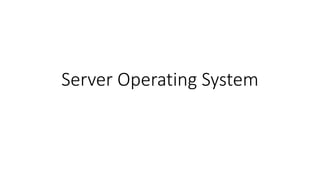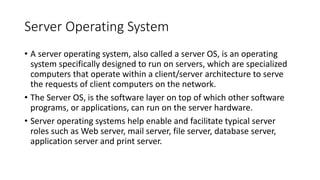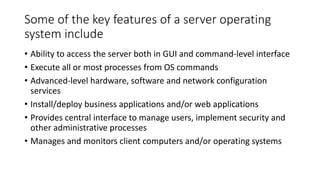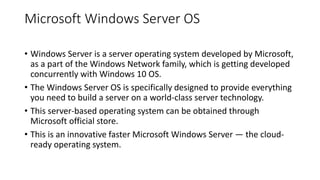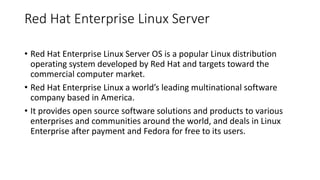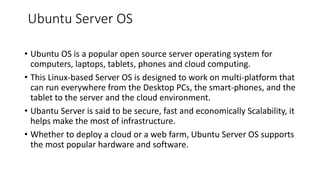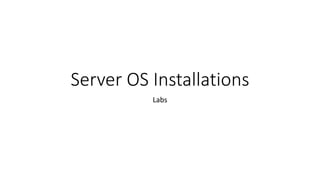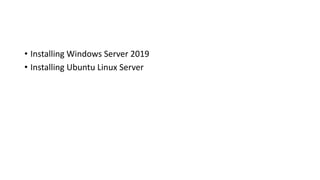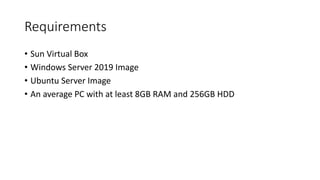System adminstration Operating_Systems.pdf
- 1. IST-2201 System Administration Lecture 3 ŌĆō Introduction to Operating System
- 2. What is an Operating System? ŌĆó OS is a system software that manages computer hardware, software resources and provides common services for computer programs. ŌĆó Other specialized classes of OS such as embedded and real time systems exist for many applications ŌĆó OS acts as an interface between computer hardware components and the user. ŌĆó Every computer system must have at least one operating system to run other programs. ŌĆó Applications like Browsers, MS Office, Notepad Games, etc., need some environment to run and perform its tasks. ŌĆó It is the most important program that runs on your computer. It manages all other programs on the machine. ŌĆó It performs basic tasks, such as: ŌĆó Recognizing input from the keyboard or mouse, ŌĆó Sending output to the monitor ŌĆó Keeping track of files and directories on the disk, and ŌĆó Controlling peripheral devices such as disk drives and printers.
- 3. Examples of Operating System with Market Share ŌĆó Following are the Operating System examples with the latest Market Share OS Name Share Windows 40.34 Android 37.95 iOS 15.44 Mac OS 4.34 Linux 0.95 Chrome OS 0.14 Windows Phone OS 0.06
- 4. Types of Operating System (OS) ŌĆó Following are the popular types of OS (Operating System): ŌĆó Batch Operating System ŌĆó Time-Sharing Operating Systems ŌĆó Distributed Operating System ŌĆó Network Operating System ŌĆó Real-Time Operating System
- 5. Batch Operating System ŌĆó This type of operating system does not interact with the computer directly. ŌĆó There is an operator which takes similar jobs having the same requirement and group them into batches. ŌĆó It is the responsibility of the operator to sort jobs with similar needs. Advantages of Batch Operating System ŌĆó It is very difficult to guess or know the time required for any job to complete. Processors of the batch systems know how long the job would be when it is in queue ŌĆó Multiple users can share the batch systems ŌĆó The idle time for the batch system is very less ŌĆó It is easy to manage large work repeatedly in batch systems ŌĆó Disadvantages of Batch Operating System: ŌĆó The computer operators should be well known with batch systems ŌĆó Batch systems are hard to debug ŌĆó It is sometimes costly ŌĆó The other jobs will have to wait for an unknown time if any job fails ŌĆó Examples of Batch based Operating System: Payroll System, Bank Statements, etc.
- 6. Time-Sharing Operating Systems Advantages of Time-Sharing OS: ŌĆó Each task gets an equal opportunity ŌĆó Fewer chances of duplication of software ŌĆó CPU idle time can be reduced Disadvantages of Time-Sharing OS: ŌĆó Reliability problem ŌĆó One must have to take care of the security and integrity of user programs and data ŌĆó Data communication problem ŌĆó Examples of Time-Sharing OSs are: Multics, Unix, etc. ŌĆó Each task is given some time to execute so that all the tasks work smoothly. ŌĆó Each user gets the time of CPU as they use a single system. ŌĆó These systems are also known as Multitasking Systems. ŌĆó The task can be from a single user or different users also. ŌĆó The time that each task gets to execute is called quantum. ŌĆó After this time interval is over OS switches over to the next task.
- 7. Distributed Operating System ŌĆó These types of the OS is a recent advancement in the world of computer technology and are being widely accepted all over the world and, that too, with a great pace. ŌĆó Various autonomous interconnected computers communicate with each other using a shared communication network. ŌĆó Independent systems possess their own memory unit and CPU. ŌĆó These are referred to as loosely coupled systems or distributed systems. ŌĆó These systemŌĆÖs processors differ in size and function. ŌĆó The major benefit of working with these types of the OS is that it is always possible that one user can access the files or software which are not actually present on his system but some other system connected within this network ŌĆó i.e., remote access is enabled within the devices connected in that network. Advantages of Distributed Operating System: ŌĆóFailure of one will not affect the other network communication, as all systems are independent from each other ŌĆóElectronic mail increases the data exchange speed ŌĆóSince resources are being shared, computation is highly fast and durable ŌĆóLoad on host computer reduces ŌĆóThese systems are easily scalable as many systems can be easily added to the network ŌĆóDelay in data processing reduces Disadvantages of Distributed Operating System: ŌĆóFailure of the main network will stop the entire communication ŌĆóTo establish distributed systems the language which is used are not well defined yet ŌĆóThese types of systems are not readily available as they are very expensive. Not only that the underlying software is highly complex and not understood well yet Examples of Distributed Operating System are- LOCUS, etc.
- 8. Network Operating System ŌĆó These systems run on a server and provide the capability to manage data, users, groups, security, applications, and other networking functions. ŌĆó These types of OS allow shared access of files, printers, security, applications, and other networking functions over a small private network. ŌĆó One more important aspect of Network OS is that all the users are well aware of the underlying configuration, of all other users within the network, their individual connections, etc. and thatŌĆÖs why these computers are popularly known as tightly coupled systems. Advantages of Network Operating System: ŌĆóHighly stable centralized servers ŌĆóSecurity concerns are handled through servers ŌĆóNew technologies and hardware up-gradation are easily integrated into the system ŌĆóServer access is possible remotely from different locations and types of systems Disadvantages of Network Operating System: ŌĆóServers are costly ŌĆóUser has to depend on a central location for most operations ŌĆóMaintenance and updates are required regularly Examples of Network Operating System are: Microsoft Windows Server 2003, Microsoft Windows Server 2008, UNIX, Linux, Mac OS X, Novell NetWare, and BSD, etc.
- 9. Real-Time Operating System ŌĆó These types of OSs serve real-time systems. The time interval required to process and respond to inputs is very small. This time interval is called response time. ŌĆó Real-time systems are used when there are time requirements that are very strict like missile systems, air traffic control systems, robots, etc. Two types of Real-Time Operating System which are as follows: ŌĆó Hard Real-Time Systems: ŌĆó These OSs are meant for applications where time constraints are very strict and even the shortest possible delay is not acceptable. ŌĆó These systems are built for saving life like automatic parachutes or airbags which are required to be readily available in case of any accident. ŌĆó Virtual memory is rarely found in these systems. ŌĆó Soft Real-Time Systems: ŌĆó These OSs are for applications where for time-constraint is less strict. Advantages of RTOS: ŌĆóMaximum Consumption: Maximum utilization of devices and system, thus more output from all the resources ŌĆóTask Shifting: The time assigned for shifting tasks in these systems are very less. For example, in older systems, it takes about 10 microseconds in shifting one task to another, and in the latest systems, it takes 3 microseconds. ŌĆóFocus on Application: Focus on running applications and less importance to applications which are in the queue. ŌĆóReal-time operating system in the embedded system: Since the size of programs are small, RTOS can also be used in embedded systems like in transport and others. ŌĆóError Free: These types of systems are error-free. ŌĆóMemory Allocation: Memory allocation is best managed in these types of systems. Disadvantages of RTOS: ŌĆóLimited Tasks: Very few tasks run at the same time and their concentration is very less on few applications to avoid errors. ŌĆóUse heavy system resources: Sometimes the system resources are not so good and they are expensive as well. ŌĆóComplex Algorithms: The algorithms are very complex and difficult for the designer to write on. ŌĆóDevice driver and interrupt signals: It needs specific device drivers and interrupts signals to respond earliest to interrupts. ŌĆóThread Priority: It is not good to set thread priority as these systems are very less prone to switching tasks. Examples of Real-Time Operating Systems are: Scientific experiments, medical imaging systems, industrial control systems, weapon systems, robots, air traffic control systems, etc.
- 10. Functions of Operating System ŌĆó Some typical operating system functions may include managing memory, files, processes, I/O system & devices, security, etc. ŌĆó Below are the main functions of Operating System: Source: Guru99
- 11. Functions of Operating System ŌĆó Process management:- Process management helps OS to create and delete processes. It also provides mechanisms for synchronization and communication among processes. ŌĆó Memory management:- Memory management module performs the task of allocation and de-allocation of memory space to programs in need of this resources. ŌĆó File management:- It manages all the file-related activities such as organization storage, retrieval, naming, sharing, and protection of files. ŌĆó Device Management: Device management keeps tracks of all devices. This module also responsible for this task is known as the I/O controller. It also performs the task of allocation and de-allocation of the devices. ŌĆó I/O System Management: One of the main objects of any OS is to hide the peculiarities of that hardware devices from the user. ŌĆó Secondary-Storage Management: Systems have several levels of storage which includes primary storage, secondary storage, and cache storage. Instructions and data must be stored in primary storage or cache so that a running program can reference it. ŌĆó Security:- Security module protects the data and information of a computer system against malware threat and authorized access. ŌĆó Command interpretation: This module is interpreting commands given by the and acting system resources to process that commands. ŌĆó Networking: A distributed system is a group of processors which do not share memory, hardware devices, or a clock. The processors communicate with one another through the network. ŌĆó Job accounting: Keeping track of time & resource used by various job and users. ŌĆó Communication management: Coordination and assignment of compilers, interpreters, and another software resource of the various users of the computer systems.
- 12. Features of Operating System (OS) ŌĆó Here is a list important features of OS: ŌĆó Protected and supervisor mode ŌĆó Allows disk access and file systems Device drivers Networking Security ŌĆó Program Execution ŌĆó Memory management Virtual Memory Multitasking ŌĆó Handling I/O operations ŌĆó Manipulation of the file system ŌĆó Error Detection and handling ŌĆó Resource allocation ŌĆó Information and Resource Protection
- 13. Advantage of using Operating System ŌĆó Allows you to hide details of hardware by creating an abstraction ŌĆó Easy to use with a GUI ŌĆó Offers an environment in which a user may execute programs/applications ŌĆó The operating system must make sure that the computer system convenient to use ŌĆó Operating System acts as an intermediary among applications and the hardware components ŌĆó It provides the computer system resources with easy to use format ŌĆó Acts as an intermediator between all hardwareŌĆÖs and softwareŌĆÖs of the system
- 14. Disadvantages of using Operating System ŌĆó If any issue occurs in OS, you may lose all the contents which have been stored in your system ŌĆó Operating systemŌĆÖs software is quite expensive for small size organization which adds burden on them. Example Windows ŌĆó It is never entirely secure as a threat can occur at any time
- 15. What is Kernel in Operating System? ŌĆó The kernel is the central component of a computer operating systems. ŌĆó The only job performed by the kernel is to the manage the communication between the software and the hardware. ŌĆó A Kernel is at the nucleus of a computer. It makes the communication between the hardware and software possible. ŌĆó While the Kernel is the innermost part of an operating system, a shell is the outermost one.
- 16. Difference between Firmware and Operating System Firmware Operating System Define Firmware: Firmware is one kind of programming that is embedded on a chip in the device which controls that specific device. Define Operating System: OS provides functionality over and above that which is provided by the firmware. Firmware is programs that been encoded by the manufacture of the IC or something and cannot be changed. OS is a program that can be installed by the user and can be changed. It is stored on non-volatile memory. OS is stored on the hard drive.
- 17. Difference between 32-Bit vs. 64 Bit Operating System Parameters 32. Bit 64. Bit Architecture and Software Allow 32 bit of data processing simultaneously Allow 64 bit of data processing simultaneously Compatibility 32-bit applications require 32-bit OS and CPUs. 64-bit applications require a 64- bit OS and CPU. Systems Available All versions of Windows 8, Windows 7, Windows Vista, and Windows XP, Linux, etc. Windows XP Professional, Vista, 7, Mac OS X and Linux. Memory Limits 32-bit systems are limited to 3.2 GB of RAM. 64-bit systems allow a maximum 17 Billion GB of RAM.
- 19. Server Operating System ŌĆó A server operating system, also called a server OS, is an operating system specifically designed to run on servers, which are specialized computers that operate within a client/server architecture to serve the requests of client computers on the network. ŌĆó The Server OS, is the software layer on top of which other software programs, or applications, can run on the server hardware. ŌĆó Server operating systems help enable and facilitate typical server roles such as Web server, mail server, file server, database server, application server and print server.
- 20. Some of the key features of a server operating system include ŌĆó Ability to access the server both in GUI and command-level interface ŌĆó Execute all or most processes from OS commands ŌĆó Advanced-level hardware, software and network configuration services ŌĆó Install/deploy business applications and/or web applications ŌĆó Provides central interface to manage users, implement security and other administrative processes ŌĆó Manages and monitors client computers and/or operating systems
- 21. Most Popular Server Operating Systems ŌĆó Some of the worldŌĆÖs most popular server operating systems with enterprise class management and administrative tools! ŌĆó Microsoft Windows Server OS ŌĆó Red Hat Enterprise Linux Server ŌĆó Ubuntu Server OS ŌĆó CentOS Server ŌĆó SUSE Enterprise Linux Server ŌĆó Oracle Linux Server ŌĆó ClearOS Server
- 22. Microsoft Windows Server OS ŌĆó Windows Server is a server operating system developed by Microsoft, as a part of the Windows Network family, which is getting developed concurrently with Windows 10 OS. ŌĆó The Windows Server OS is specifically designed to provide everything you need to build a server on a world-class server technology. ŌĆó This server-based operating system can be obtained through Microsoft official store. ŌĆó This is an innovative faster Microsoft Windows Server ŌĆö the cloud- ready operating system.
- 23. Red Hat Enterprise Linux Server ŌĆó Red Hat Enterprise Linux Server OS is a popular Linux distribution operating system developed by Red Hat and targets toward the commercial computer market. ŌĆó Red Hat Enterprise Linux a worldŌĆÖs leading multinational software company based in America. ŌĆó It provides open source software solutions and products to various enterprises and communities around the world, and deals in Linux Enterprise after payment and Fedora for free to its users.
- 24. Ubuntu Server OS ŌĆó Ubuntu OS is a popular open source server operating system for computers, laptops, tablets, phones and cloud computing. ŌĆó This Linux-based Server OS is designed to work on multi-platform that can run everywhere from the Desktop PCs, the smart-phones, and the tablet to the server and the cloud environment. ŌĆó Ubantu Server is said to be secure, fast and economically Scalability, it helps make the most of infrastructure. ŌĆó Whether to deploy a cloud or a web farm, Ubuntu Server OS supports the most popular hardware and software.
- 25. CentOS Server ŌĆó CentOS is another Linux OS distribution that attempts to provide a free, enterprise-class, community-supported computing platform functionally compatible with its upstream source, Red Hat Enterprise Linux. ŌĆó A community enterprise OS, that is a free rebuild of open source packages from the popular Red Hat Enterprise Linux. ŌĆó CentOS has a group for open source community of contributors and users working on development and adoption of next-generation projects. ŌĆó A free OS focused on delivering a robust open source ecosystem.
- 26. SUSE Enterprise Linux Server ŌĆó SUSE OS is a Linux-based computer operating system. ŌĆó It is built on top of the open source Linux kernel and is distributed with system and application software from other open source projects. ŌĆó This premier Linux operating system built for the enterprises, works perfectly on a variety of hardware platforms. ŌĆó SUSE Linux Enterprise Server is a leading server operating system by SUSE. ŌĆó It is designed for servers, mainframes, and workstations but can be installed on desktop computers for personal and as well as testing purpose.
- 27. Oracle Linux Server ŌĆó Oracle Linux Server is an open, cloud-ready infrastructure, that can be used throughout Oracle Cloud and Oracle engineered systems, Oracle Linux Server is a proven operating system that is available in the cloud, on premises, or as an embedded system. ŌĆó Oracle Linux server is designed to provide the reliability, scalability, security, and performance for demanding enterprise workloads. ŌĆó It is built for enterprise-level experience.
- 28. ClearOS Server ŌĆó ClearOS, a Linux-based open-source operations system to redefine the small business server needs, making it a customizable, easy-to- use software platform that is designed to improve business outcomes and reduce costs in the process. ŌĆó Their goal is to provide SMBs with fully functional servers that come with ClearOS, an operating system with an Application Marketplace at no extra cost and the flexibility to customize as needed and required on time
- 30. ŌĆó Installing Windows Server 2019 ŌĆó Installing Ubuntu Linux Server
- 31. Requirements ŌĆó Sun Virtual Box ŌĆó Windows Server 2019 Image ŌĆó Ubuntu Server Image ŌĆó An average PC with at least 8GB RAM and 256GB HDD
